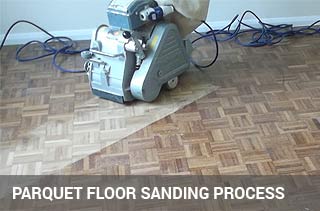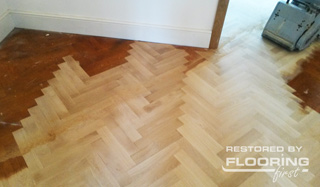Back to Floor Sanding
Why Parquet Flooring Sanding is Not Recommended for DIY
It is great to be a DIY enthusiast - the joy of being able to do something more complicated by yourself is very important to every person's self-esteem. Colouring the walls of your home, or making a decoration from old unusable material, is a good way to start DIY-ing, but certain procedures might be better left to professionals. A good example is parquet floor sanding and restoration.
DIY Floor Sanding, Why Not?
This is not just about parquet sanding, but for the floor restoration as a whole. Patience is a trait that not everyone possesses and time is a luxury not everyone can afford. Besides, while many of us won’t admit it, more than a few among us simply lack the will to see some tasks to their completion. We grow bored or discouraged or find some excuse not to proceed. Floor sanding can be painful and costly, especially for those who have never attempted something similar before. Try it at your own risk, but if you do, give it your best. Unfortunately, we have seen many DIY projects which were left abandoned at some point and only made our work harder later on.
Straight and Across or Diagonal Sanding?
 To sand a floor properly, you must understand the nature of the wood. Let’s begin with the basics. What is grain? According to Wikipedia, the longitudinal arrangement of wood fibres. The first thing anyone entering the field of floor restoration learns is to follow the grain of the wood when sanding.
To sand a floor properly, you must understand the nature of the wood. Let’s begin with the basics. What is grain? According to Wikipedia, the longitudinal arrangement of wood fibres. The first thing anyone entering the field of floor restoration learns is to follow the grain of the wood when sanding.
There are three stages of floor sanding – rough, medium and fine. Rough sanding uses coarse abrasives and removes the most worn parts of the floor. Medium, as the name suggests, is the middle ground, where the surface slowly begins to take shape and even out. Finally, we have fine sanding with high-grit sandpaper (we use up to 120), which truly allows the floor to become perfectly smooth.
Now, when doing rough sanding, some people attempt to strip the wood diagonally, because it cuts faster. That is all fine and good, but it also hurts the grain and it may become noticeable when you add the finish much later. For this reason, it is better to sand straight first and leave the grain untouched. Diagonal sanding has its place when working on very uneven, distressed surfaces, where it is simply more efficient to remove more material at once.
Sanding a Herringbone Parquet
 And here comes parquet flooring, where there are rows of blocks facing opposite directions. How do you sand with the grain of one side without going against the other? There are two conflicting opinions on how to best approach this task. You have to stand straight and across or diagonally. We shall try to explain both points of view.
And here comes parquet flooring, where there are rows of blocks facing opposite directions. How do you sand with the grain of one side without going against the other? There are two conflicting opinions on how to best approach this task. You have to stand straight and across or diagonally. We shall try to explain both points of view.
Straight and Across at 90 degrees of each other. Those who use this method claim that sanding diagonally makes you strip some blocks more than others, given the different grain direction, which eventually leads to an uneven surface. While standing straight and across, you never strip the grain fully in either direction, so you also never remove too much.
Diagonally. Those who prefer to go this route believe that it is ok to strip the wood straight and across when performing rough and medium sanding. However, for the fine sanding, it is needed to do around at least once for each diagonal. By doing this, you follow the grain once and then go in the opposite direction. This is the method most flooring experts seem to use.
The main idea here is not to follow instructions blindly but to see what works best for you. Both ways of sanding the parquet should get the job done, but it depends on your skills to finish the task properly. However, always be mindful of how you use your belt sander. Don’t forget that it strips the wood constantly as long as it is working, and stopping in place for even a few moments can dent your floor.
Very useful pieces of equipment are the Lagler Trio and its alternative, BonaFlexi Sand. Those machines possess drive plates with multiple separately driven heads, which can help you buff the floor and make the grain more consistent. However, they only work on flat surfaces and, because of this cannot replace the belt sander.
Our flooring service comes with obligation-free site visit, quick quotations and free advice. Give us a call on 020 88309782 to speak to a member of our staff, who can arrange for a free assessment of your floor sanding or wood floor fitting service at a convenient for you time.